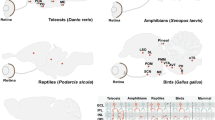Summary
The retinal rods, cones and epithelial pigment of most lower vertebrates display rhythmic photomechanical (retinomotor) migrations in response to changes in ambient lighting conditions. This study examines the extent of these migrations in the absence of the daily changes in illumination (constant darkness and constant light) in three species of teleosts.
Salmo trutta, a crepuscularly active fish, showed two peaks of light adaptation occurring around dawn and dusk when kept in constant darkness. Tinca tinca, a nocturnal species, also showed an endogenous rhythm during extended periods of darkness, but, unlike Salmo trutta, it was light-adapted throughout what would normally have been “day”. At the maximal extent of migration under conditions of continual darkness, the pigment migrated 59% as much as it did during a normal light/dark cycle. Nannacara anomala, a tropical diurnally active species, showed a similar but more pronounced rhythm than Tinea tinea for all 3 days of experimental darkness, behaving essentially identically to fish exposed to a light/dark cycle. Nannacara anomala also displayed a weak rhythm when kept in constant light.
It is concluded from these and previous results that the pattern of endogenous photomechanical movement depends both on the activity pattern of a species and on the constancy of the lighting conditions to which it has been exposed during its lifetime.
Similar content being viewed by others
References
Ali MA (1959) The ocular structure, retinomotor and photobehavioral responses of juvenile pacific salmon. Can J Zool 37:969–996
Ali MA (1961) Histophysiological studies on the juvenile Atlantic salmon (Salmo salar) retina. II. Responses to light intensities, wavelengths, temperature, and continuous light or dark. Can J Zool 39:511–526
Ali MA (1964) Retinomotor responses of the goldfish (Carassius auratus) to unilateral photic stimulation. Rev Can Biol 23:45–53
Ali MA, Wagner HJ (1975) Distribution and development of retinomotor responses. In: Ali MA (ed) Vision in fishes. Plenum Press, New York London, pp 369–396
Arey LB, Mundt GH (1941) A persistent diurnal rhythm in visual cones. Anat Rec 79 (suppl) abstr 41
Douglas RH (1982) An endogenous crepuscular rhythm of rainbow trout (Salmo gairdneri) photomechanical movements. J Exp Biol 96:377–388
Finneran BA, Nicol JAC (1974) Studies on the eyes of New Zealand parrot-fishes (Labridae). Proc R Soc Lond B 186:217–247
John KR, Gring DM (1968) Retinomotor rhythms in the bluegill, Lepomis macrochirus. J Fish Res Bd Can 25:373–381
John KR, Haut M (1964) Retinomotor cycles and correlated behaviour in the teleost Astyanax mexicanus (Fillipi). J Fish Res Bd Can 21:591–595
John KR, Kaminester LH (1969) Further studies on retinomotor rhythms in the teleost Astyanax mexicanus. Physiol Zool 42:60–70
John KR, Segall M, Zawatzky L (1967) Retinomotor rhythms in the goldfish, Carassius auratus. Biol Bull 132:200–210
Levinson G, Burnside B (1981) Circadian rhythms in teleost retinomotor movements: A comparison of the effects of circadian rhythm and light condition on cone length. Invest Ophthalmol 20:294–303
Muntz WRA, Richard DS (1982) Photomechanical movements in the trout retina following brief flashes of light. Vis Res 22(5):529–530
Olla BL, Marchioni WW (1968) Rhythmic movements of cones in the retina of bluefish, Pomatomus saltatrix, held in constant darkness. Biol Bull 135:530–536
Peyrauld C (1966) Contribution à l'étude de la dynamique des pigments et des photorécepteurs rétiniens chez la Carpe (Cyprinius carpio L.). C R Acad Sc Paris 263:65–67
Richardson KC, Jarett L, Finke EH (1960) Embedding in epoxy resins for ultrathin sectioning in electron microscopy. Stain Technol 35:313–323
Siegmund R (1969) Lokomotorische Aktivität und Ruheverhalten bei einheimischen Süßwasserfischen (Pisces, Percidae, Cyprinidae). Biol Zbl 88:295–312
Wagner HJ, Ali MA (1977) Cone synaptic ribbons and retinomotor changes in the brook trout, Salvelinus fontinalis (Salmonidae, Teleostei), under various experimental conditions. Can J Zool 55:1684–1691
Wagner HJ, Douglas RH (1982) Morphological changes in teleost primary and secondary retinal cells following brief exposure to light. Invest Ophthalmol Vis Sci (in press)
Welsh JH, Osborn CM (1937) Diurnal changes in the retina of the catfish, Ameiurus nebulosus. J Comp Neurol 66:349–359
Author information
Authors and Affiliations
Rights and permissions
About this article
Cite this article
Douglas, R.H., Wagner, H.J. Endogenous patterns of photomechanical movements in teleosts and their relation to activity rhythms. Cell Tissue Res. 226, 133–144 (1982). https://doi.org/10.1007/BF00217088
Accepted:
Issue Date:
DOI: https://doi.org/10.1007/BF00217088




